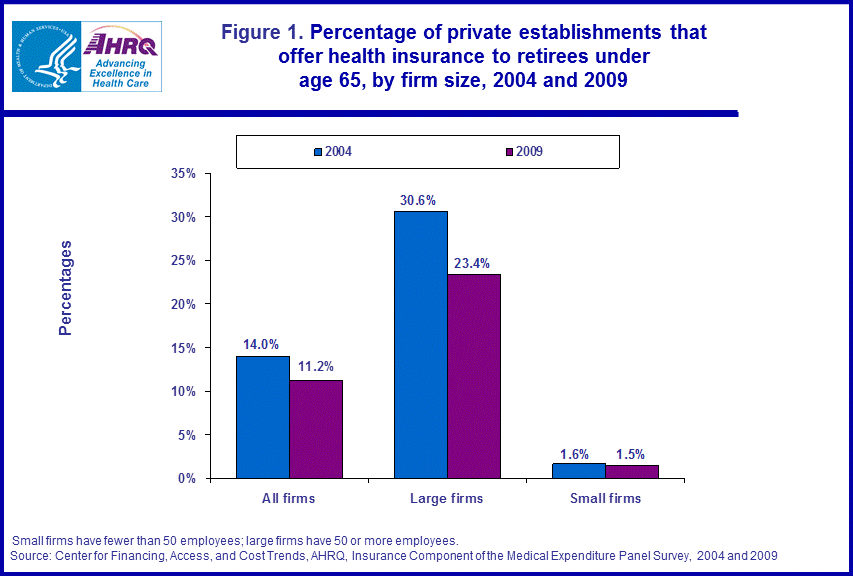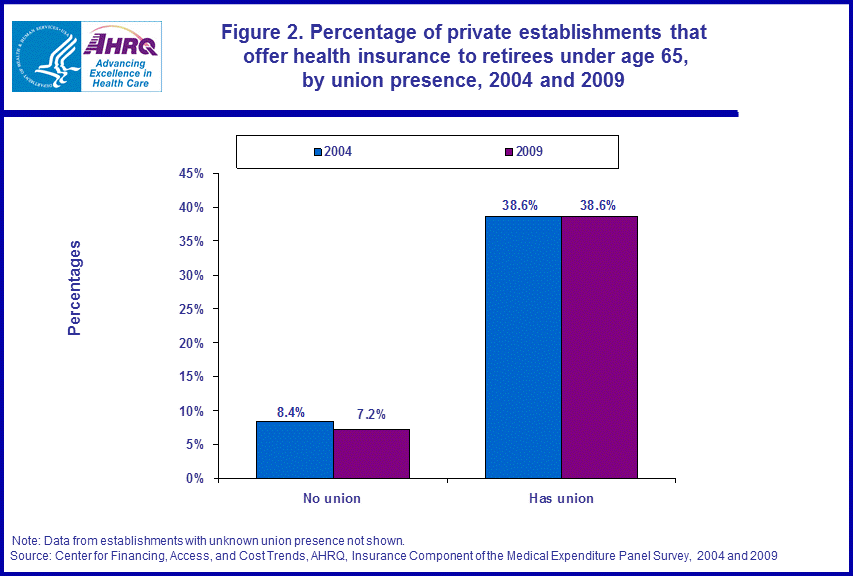
|
|
Font Size:
|
||||
|
|
|
|
||||
STATISTICAL BRIEF #333:
Employer-Sponsored Health Insurance for Early Retirees in the Private Sector, 2004 and 2009
Highlights
- The percentage of establishments of large (50 or more employees) private sector firms offering health insurance to employees who retire before age 65 was higher in 2004 than 2009 (30.6 percent versus 23.4 percent). For establishments of small (fewer than 50 employees) employers, early retiree coverage did not change significantly during this period.
- Private sector establishments with unions are more likely to offer early retiree coverage than establishments without unions. Between 2004 and 2009, the percentage of private sector establishments with unions offering health insurance to employees who retire before age 65 remained the same at 38.6 percent. Private sector establishments without unions offering early coverage declined slightly from 8.4 percent to 7.2 percent.
- Annual health insurance premiums per enrolled early retiree averaged $5,960 for single coverage and $14,164 for family coverage in 2009.
Introduction
Employer-sponsored health insurance for early retirees, employees who retire before age 65, is a valuable employment benefit. Beginning in 2010, the Early Retiree Reinsurance Program, established under the Patient Protection and Affordable Care Act, provides reimbursement to sponsors of plans to provide premium relief to their retirees and employees, to offset increases in their own health care premiums or costs, or for a combination of these purposes. The program is expected to end on January 1, 2014, when early retirees and their families, along with others, will be able to choose from a range of coverage options that will be available in new state-based health insurance exchanges.Using data from the 2004 and 2009 Medical Expenditure Panel Survey Insurance Component (MEPS-IC), this Statistical Brief examines trends and variation in availability of employer-sponsored health insurance for early retirees in the private sector by firm size, union presence, and ownership type (see Appendix for distributions of these characteristics). The Brief also provides estimates on average premiums for both single and family early retiree coverage. Only differences between estimates at the 0.05 percent significance level are noted in the text.
Findings
Overall, a smaller percentage of private sector establishments offered health insurance to retirees under 65 in 2009 than 2004 (11.2 versus 14.0 percent) (figure 1). While the percentage of establishments in large firms (50 or more employees) that offered early retiree coverage was notably lower in 2009 (23.4 percent versus 30.6 percent in 2004), the percentage of establishments in small firms offering such coverage was essentially the same in both years (about 1.5 percent).Private sector establishments with unions are much more likely to offer early retiree coverage than establishments without unions. About 39 percent of private sector establishments with unions offered health insurance to employees who retire before age 65 in both 2004 and 2009 (figure 2). However, private sector establishments without unions offering early retiree coverage declined slightly from 8.4 percent to 7.2 percent.
In 2009, 12.5 percent of for profit, incorporated establishments and 7.2 percent of for profit, unincorporated establishments offered health insurance to retirees under 65 (figure 3). These estimates represent a decline in early retiree coverage relative to their corresponding values in 2004 (15.3 percent and 11.4 percent, respectively). The percentage of nonprofit establishments offering such coverage was similar in both years (nearly 8 percent).
Average annual health insurance premiums per enrolled early retiree with single coverage increased 28.4 percent from $4,640 in 2004 to $5,960 in 2009 (figure 4). The average annual premium for early retirees with family coverage rose 40 percent during this period, from $10,124 to $14,164. Both of these increases exceeded the 13.6 percent rise between 2004 and 2009 in overall consumer prices for urban consumers (i.e., CPI index).
Data Source
This Statistical Brief summarizes data from the 2004 through 2009 MEPS-IC. The data are available on the MEPS Web site at http://www.meps.ahrq.gov/mepsweb/survey_comp/Insurance.jsp or have been produced using special computation runs on the confidential MEPS-IC data available at the U.S. Census Bureau.Definitions
EmployerIn this Statistical Brief, an employer is defined as an establishment in private sector firm. A firm is defined as a business entity that controls one or more business establishments or locations. Only employers offering health insurance to employees who retire before age 65 were included in this analysis.
Establishment
A particular workplace or physical location where business is conducted or services or industrial operations are performed. Also known as site.
Family coverage
Health insurance that covers the employee and one or more members of his/her immediate family (spouse and/or children as defined by the plan). For the MEPS-IC survey, “family coverage” is any coverage other than single and employee-plus-one. Some plans offer more than one rate for family coverage, depending on family size and composition. If more than one rate is offered, survey respondents are asked to report costs for a family of four.
Ownership type
- For profit, incorporated: A firm that is granted a charter recognizing it as a separate legal entity having its own privileges, and liabilities from those of its members.
- For profit, unincorporated: A firm with a sole owner or a partnership where two or more persons join to carry on a trade or business with each having a shared financial interest in the business.
- Nonprofit: A firm that does not distribute surplus funds to its owners or shareholders, but instead uses surplus funds to help pursue its goals. Most nonprofits are exempt from taxes.
Agreed upon fees paid for coverage of medical benefits for a defined benefit period. Premiums can be paid by employers, unions, employees, or split between the insured individual and the plan sponsor.
Single coverage
Health insurance that covers the employee only. This is also known as employee-only coverage.
Union presence
An establishment has a union presence if any of its employees are covered by a collective bargaining agreement.
| Appendix: Percentage of private sector establishments by selected characteristics, 2004 and 2009 | ||
| Characteristics | 2004 | 2009 |
|---|---|---|
| Firm size | ||
| Less than 50 employees | 75.6% | 74.6% |
| 50 or more employees | 24.4% | 25.4% |
| Ownership type | ||
| For profit, incorporated | 68.6% | 68.2% |
| For profit, unincorporated | 23.3% | 24.0% |
| Nonprofit | 8.1% | 7.8% |
| Union presence | ||
| No union | 88.8% | 90.8% |
| Has union | 4.7% | 5.4% |
| Unknown | 6.5% | 3.9% |
About MEPS-IC
The MEPS-IC is a survey of business establishments and governments that collects information on employer-sponsored health insurance, such as whether insurance is offered, enrollments, types of plans, and premiums. The survey is conducted annually by the U.S. Census Bureau under the sponsorship of the Agency for Healthcare Research and Quality. A total sample of 42,000 establishments was selected for the 2010 survey; with 8.3 percent of the sample determined to be out-of-scope during the data collection process. The response rate for the private sector was 82.7 percent of the in-scope sample units.For more information on this survey, see MEPS Methodology Reports 6, 8, 10, 14, 17, and 18 under MEPS publications at http://www.meps.ahrq.gov/mepsweb/data_stats/publications.jsp and the MEPS Insurance/Employer Component Survey Basics at http://www.meps.ahrq.gov/mepsweb/survey_comp/Insurance.jsp.
References
U.S. Department of Health and Human Services. Fact Sheet: The Affordable Care Act’s Early Retiree Reinsurance Program. Available at: http://www.healthcare.gov/news/factsheets/early_retiree_reinsurance_program.htmlU.S. Department of Health and Human Services. Report on Implementation and Operation of the Early Retiree Reinsurance Program during Calendar Year 2010 (3/02/11). http://www.healthcare.gov/center/reports/retirement03022011a.pdf
Suggested Citation
Davis, K. Employer-Sponsored Health Insurance for Early Retirees in the Private Sector, 2004 and 2009. Statistical Brief #333. August 2011. Agency for Healthcare Research and Quality, Rockville, MD. http://www.meps.ahrq.gov/mepsweb/data_files/publications/st333/stat333.shtmlAHRQ welcomes questions and comments from readers of this publication who are interested in obtaining more information about access, cost, use, financing, and quality of health care in the United States. We also invite you to tell us how you are using this Statistical Brief and other MEPS data and tools and to share suggestions on how MEPS products might be enhanced to further meet your needs. Please e-mail us at MEPSProjectDirector@ahrq.hhs.gov or send a letter to the address below:
Steve B. Cohen, PhD, Director
Center for Financing, Access, and Cost Trends
Agency for Healthcare Research and Quality
540 Gaither Road
Rockville, MD 20850
 |
||||||||||||||||||||
|
||||||||||||||||||||
|
|
||||||||||||||||||||
 |
||||||||||||||||||||
|
||||||||||||||||||||
|
|
||||||||||||||||||||
 |
||||||||||||||||||||
|
||||||||||||||||||||
|
|
||||||||||||||||||||
 |
||||||||||||||||||||
|
||||||||||||||||||||
|
|
||||||||||||||||||||


